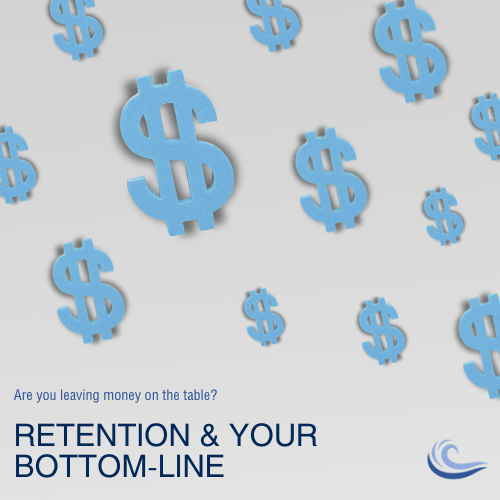Are You Leaving Money on the Table?
For the sake of argument, let’s say, as a small business leader, you are old-school. What you care about is the bottom-line. Well, fair enough, because ultimately whether you are an old or new school leader, a desired result of your business is to make a profit. Employee retention has a profound impact on your bottom-line and often is overlooked as a major player in your business finances. So, even though there is not a line item on your P&L it is important to understand and acknowledge that employee retention is lurking there, and if you don’t address it, you are effectively leaving money on the table…
Customer Relationships
Are you aware that your high employee turnover disrupts your customer relationships and leads to a decline in customer satisfaction and loyalty? Remember it is your employees who serve as the primary point of contact between your business and your customers. High turnover leads to inconsistent service and instead of building ever deeper customer relationships your business is now expending energy to repeatedly rebuild rapport over and over. This undoubtedly not only results in lost sales but is negatively affecting repeat business and ultimately will damage your company’s reputation. Damaged customer relationships have a direct effect on your bottom line…
Opportunities Lost
Did know that your high turnover is distracting your key manager’s (including you)? High turnover forces you and your managers to focus on staffing issues and covering the day-to-day operations neglected when there is a staffing shortage. It effectively takes your eye off the ball (any strategic initiatives,) and leads to missed opportunities for market expansion, growth and innovation. The opportunities you lose have a significant cost and ultimately affect your company’s competitive position and your long-term profitability…
Productivity Gaps
Are you aware that your high turnover rates are disrupting the continuity of work and are creating significant productivity losses for your business? Specifically, when your key players or highly experienced employees leave, they take valuable organizational knowledge and skills with them. The time it takes to hire someone new does not replace those skills. Imagine if your best salesperson left your company. How long do you think it would take for that person’s replacement to consistently reach their predecessor’s numbers? Now do the math in terms of money spent on the replacement (salary, training, benefits, etc.) and think about it in terms of how much time to full productivity. Its expensive because it creates a productivity gap that no small business can afford. In addition, the productivity gap results in reduced work quality, and missed deadlines and milestones, which negatively impact your company’s bottom line.
The Cost of Recruitment & Onboarding
Are you aware the cost of replacing an employee can range from 20% to 213% of their annual salary, depending on the role’s seniority and specialization? Recruitment and onboarding due to low retention have an immediate negative financial impact on your company. These costs encompass advertising job openings, hiring recruitment agencies, conducting interviews, and processing new hires which can add up quickly. All of which negatively affects your bottom-line.
The Cost of Training & Development
Did you know that the need to continuously train new hires due to high turnover increases your overall training costs and diverts resources from other critical business activities? Investing in training and development is essential but are you investing in training employees only for them to leave and take the investment you made with them? High turnover both wastes training dollars and reduces your ability to engage in deeper employee development. It is money on the table today…and tomorrow.
Compensation & Benefits
Are you throwing money at your company’s retention problem? Are you offering higher salaries, signing bonuses or enhanced benefits to counteract high turnover? While these measures might help mitigate turnover in the short-term, they also increase your compensation expenses. If it is higher salaries, that is a year over year loss of funds right from the start. The most important thing to mention about this type of spending is that it will not work long-term. If you do not address the core issues causing turnover at your company throwing money at the problem is just expensive and ineffective.
Fear
Are you aware that high turnover can create an unstable work environment. One of the core needs your employees have is stability. Your unstable work environment will lead to decreased morale and engagement along with uncertainty and a sense of instability from your employees who remain. On top of which, your staffing issues are likely causing increased workloads that breed burn-out. Without doubt this causes further attrition. It hits your bottom-line in the form of lower productivity and more errors. The fear your high turnover creates is costing your company money every day.
Your poor employee retention has far-reaching financial implications that extend beyond the obvious and negatively affect your bottom-line. To address this, you must invest in effective retention strategies. By prioritizing employee retention, you can safeguard your business’s financial stability and position your company for long-term success.
If you are ready to address your employee retention issues but don’t know where to begin, we can help!

Jennifer Fullman, SHRM-SCP
Principal, Estuary Human Resources

